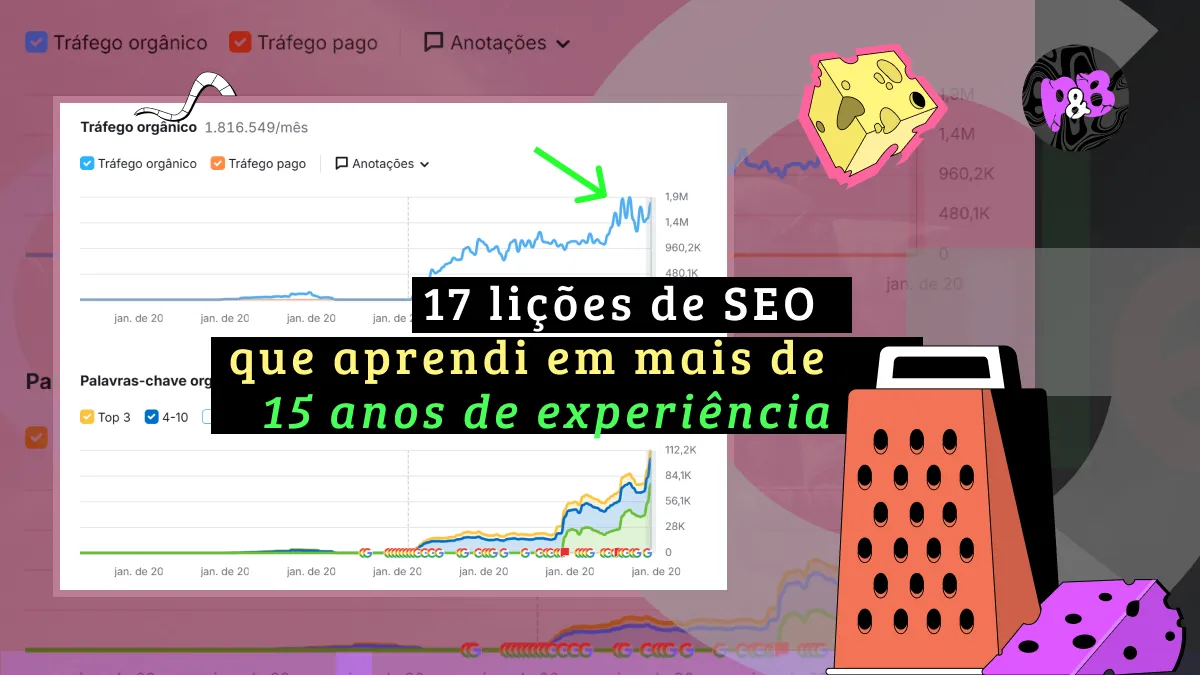17 SEO Lessons Learned from Over 15 Years of Experience
From traditional SEO to the era of generative search: what truly works (and will continue to work)

With over fifteen years of experience in digital development and acquisition, the rats at Pink and Brain can confidently share what has worked and will continue to make sense in organic acquisition strategies. In this guide, you’ll find 17 practical lessons covering technical SEO, on-page, off-page, strategy, and data—insights that remain relevant even in the new era of AI-powered search.
SEO stands for Search Engine Optimization, a practice that involves a set of techniques used to improve the ranking of web pages in search engines like Google. The main goal is to have content appear among the top organic results—that is, without paying for ads.
The topic gained momentum as search engines became indispensable tools in everyday life. With the rapid growth of the internet, the number of websites and pages also increased, requiring more refined criteria to organize and rank results.
When Did SEO Begin??
SEO began to be used around 1997, when the first search engines started indexing websites in a more automated way. At that time, optimization basically meant using keywords strategically and ensuring that content was visible to search engine bots.
As algorithms became more sophisticated, SEO practices evolved as well. Today, factors like content quality, user experience, and relevance are key to achieving strong rankings.
Nowadays, SEO goes far beyond keyword selection. It involves technical aspects such as site structure, loading speed, use of structured data, and the creation of useful, trustworthy, and well-written content.
At Pink and Brain, we’ve closely followed this evolution and helped companies stand out in an increasingly competitive environment using SEO as a strategic positioning tool and a driver of digital authority. Below, you’ll find a complete overview of what has made sense since the early days of SEO, and what’s trending in the field today.
SEO stands for Search Engine Optimization—a set of techniques used to improve the visibility of web pages in search engines like Google. The goal is to appear among the top organic results, without paying for ads. As search engines became essential tools in daily life, SEO grew in importance. With the explosion of websites, ranking criteria became more refined and competitive.
After hundreds of audits and thousands of optimized pages, the team at Pink and Brain shares 17 practical lessons that continue to make sense in today’s AI-driven search landscape.
17 Lessons from the Field
1. Technical SEO is the foundation of everything
If your site can’t be crawled, it won’t be found. Content without a solid technical base risks invisibility—not just to Google, but to generative AI systems too.
2. JavaScript can be a trap
Powerful but risky. JS-heavy sites may look great but can block bots from indexing content. Less JS = more visibility. If using frameworks like React, Vue, or NextJS, prioritize SEO from the start.
3. Crawl budget matters (in specific cases)
Large or frequently updated sites must manage crawl budget wisely. Optimize sitemaps, block irrelevant pages, and focus on strategic URLs.
4. Server logs reveal the invisible
Logs show how bots interact with your site—what they crawl, what they skip, and where they waste time. This data is gold for optimization.
5. Core Web Vitals matter a lot
Focus on user experience metrics like LCP, FID, and CLS. Use tools like PageSpeed Insights to improve performance, but don’t obsess—balance is key.
6. Structured data boosts visibility
It adds context for search engines and enables rich results. Especially vital for e-commerce and AI-powered shopping experiences.
7. On-page SEO drives organic growth
Headings, titles, descriptions, and content structure matter. On-page optimization is under your control—and delivers consistent results.
8. Keyword research must be strategic
Don’t chase popularity. Focus on search intent, user journey, and balance between volume and competition. Quality beats quantity.
9. Keywords aren’t everything
Google now values entities, semantics, and usefulness. Since 2022, helpful content trumps keyword stuffing.
10. Internal links are the cherry on top
They connect content, distribute authority, and guide bots. A smart linking strategy can boost key pages effortlessly.
11. Backlinks aren’t that important
They help, but aren’t the holy grail. Quality content and technical excellence often outperform link-chasing. Still, when great content gets shared, the impact is huge.
12. Content optimization has changed
Forget the old playbook. Write naturally, use keyword variations, and show real expertise. Authenticity wins.
13. SEO plugins don’t tell the whole truth
Tools like Yoast and RankMath are helpful, but not infallible. Green lights don’t guarantee rankings—use them critically.
14. The right KPIs reshape your strategy
Traffic, conversions, AI visibility… Each goal needs different metrics. Choosing wisely prevents diluted strategies and poor results.
15. Attribution is hard but essential
With multiple touchpoints, tracking conversions is tricky. Use UTMs and analytics tools to measure accurately and optimize investments.
16. Black hat has a short shelf life
Tricks may work temporarily, but penalties follow. Sustainable SEO means following best practices and adapting to algorithm changes.
17. Doing the basics well brings lasting results
Before chasing hacks, master the fundamentals: crawlability, useful content, fast site. That’s the real path to the top.
In 2025, the market finally understands SEO, and it’s hotter than ever. Whether you’re optimizing for Google or preparing for AI-driven search, these lessons remain timeless.
Want help applying these insights to your own site? I’d be happy to guide you through a personalized SEO audit or content strategy.
A Pink and Brain é formada por um time de especialistas sêniores com ampla experiência no universo digital. Atuamos estrategicamente em áreas como desenvolvimento de produto, branding, aquisição de clientes, engajamento, retenção, automação e marketing de conteúdo, combinando criatividade com performance. Nossa redação é responsável por produzir e validar conteúdos que traduzem conhecimento técnico em linguagem acessível, sempre alinhados às melhores práticas de SEO, UX writing e comunicação de marca.
Pink and Brain Rats has 41 articles published on Pink and Brain. Read more.